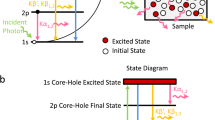Abstract
We report on the magnetic-field-dependent optically detected magnetic resonance (ODMR) spectra for polycrystalline samples of the bridged Zr(IV) metallocenes, Me2Si<(Cp2)ZrCl2 ( (dimethylsilylbis(cyclopentadienyl)zirconium-dichloride) and Me2C<(Cp2)ZrCl2 (iso-propylidenebis(cyclopentadienyl)zirconium-dichloride). ODMR spectra at zero magnetic field were recorded by frequency sweeping a microwave source from 0.1 to 10 GHz with the sample contained in a microwave helix. ODMR spectra at finite magnetic fields were recorded with the sample contained in either a helix or a slotted-tube resonator with a fixed microwave frequency and sweeping the magnetic field. For all experiments, the sample and microwave probes were contained in an immersion dewar cryostat, and the temperature was held at about 2 K. All three zero field ODMR transitions (2|E|, and |D| − |E| and |D|+|E|) were observed in the frequency-swept ODMR spectra recorded at zero and small magnetic fields. The zero-field frequency-swept spectra allowed the determination ofD andE values uniquely. For frequency-swept small-field ODMR spectra recorded at successively higher magnetic fields, each of the ODMR line intensities was observed to increase with increasing magnetic field. This intensity increase was observed for all three ODMR lines, reflecting an increase in the total intensity rather than simply a change in the polarization of the triplet sublevels. The latter would result in a change in the relative intensities of the ODMR lines but would not change simultaneously the intensities of all three lines. The ODMR line intensities increase in proportion toB n, wheren<1. This field dependence is weaker than the expected proportionalB 2 dependence from the Zeeman effect, which likely originates from the magnetic field dependence of the spin relaxation rates between the triplet sublevels. Magnetic-field-swept ODMR spectra recorded at fixed microwave frequencies in the X-band frequency range (9.8 GHz) do not show all three expected classic Pake powder pattern line shape profiles, exhibited by the molecules with their magneticZ, Y, andX axes parallel to the external magnetic field. In particular, the intensity for molecular magneticY-axes parallel to the external magnetic field is completely suppressed. In addition, an external magnetic field dependence in field-swept ODMR spectra was observed, which results in a linear decrease of the ODMR intensity with increasing strength of the external magnetic field over and above that would be expected in a polycrystalline spectrum. The data are analyzed by simulation of the continuous-wave ESR spectrum with the eigenvalues and eigenvectors of the spin Hamiltonian matrix characterizing the triplet state exhibiting the ODMR spectrum, in conjunction with homotopy, as a function of the orientations of the magnetic axes of the various molecules in a polycrystalline sample. This approach is useful to interpret the experimentally observed ODMR transition frequencies andg-values but does not take the amplitudes in the ODMR spectrum. The corrections required to modify the continuous-wave ESR spectral amplitudes that reproduce the observed ODMR amplitudes are effects associated with the ODMR processes.
Similar content being viewed by others
References
Pfennig B.W., Thompson M.E., Bocarly A.B.: Organometallics12, 649 (1993)
Togni A., Halterman R.L. (eds.): Group IV Metallocenes: Synthesis, Reactivity, Applications. Weinheim: Wiley-VCH 1998.
Moehring P.C., Coville N.J.J.: Organomet. Chem.1, 479 (1994)
Lauher J.W., Hoffmann R.J.: Am. Chem. Soc.98, 1729 (1976)
Bruce M.R.M., Kenter A., Tyler D.R.: J. Am. Chem. Soc.106, 639 (1984)
Petersen J.L., Lichtenberger D.L., Fenske R.F., Dahl L.F.: J. Am. Chem. Soc.97, 6433 (1975)
Gassman P.G., Sowa J.R. Jr., Hill M.G., Mann K.R.: Organometallics14, 4879 (1995)
Calabro D.C., Hubbard J.L., Blevins C.H., Campbell A.C., Lichtenberger D.L.: J. Am. Chem. Soc.103, 6839 (1981)
Harrigan R.W., Hammond G.S., Gray H.B.: J. Organomet. Chem.81, 79 (1974)
Kenney J.W., Boone D.R., Striplin D.R., Chen Y.-H., Hamar K.B.: Organometallics12, 3671 (1993)
Endeward B., Bernardo M., Brant P., Thomann H.: J. Am. Chem. Soc.124, 7916 (2002)
Misra S.K.: J. Magn. Reson.137, 83 (1999)
Misra S.K.: J. Magn. Reson.140, 179 (1999)
Clarke R.H. (ed.): Triplet State ODMR Spectroscopy. New York: Wiley 1982.
Diamond G.M., Jordan R.F., Petersen J.L.: Organometallics15, 4045 (1996); Nifant’ev I.E., Ivchenko P.V.: Organometallics16, 713 (1997)
Mehring M., Freysoldt F.: J. Phys. E Sci. Instrum.13, 894 (1980)
Atkins P.W., McLauchlan K.A. in: Chemically Induced Magnetic Polarization (Closs G.L., Lepley A.R., eds.). New York: Interscience 1973; Caldwell R.A.: J. Am. Chem. Soc.114, 1623 (1992)
Kamyshny A.L., Suisalu A.P., Aslanov L.A.: Coord. Chem. Rev.117, 1 (1992)
Schmidt J., Wiedenhofer H., von Zelewsky A., Yersin H.: J. Phys. Chem.99, 226 (1995); Yersin H., Humbs W., Strasser J.: Coord. Chem. Rev.159, 325 (1997)
Misra S.K. in: Handbook of Electron Spin Resonance (Poole C.P. Jr., Farach H.AA., ed.), vol. 2, pp. 115–150. New York. American Institute of Physics 1999.
Chan I., Pratt D.W. in: Triplet State ODMR Spectroscopy (Clarke R. H., ed.). New York: Wiley 1982.
Misra S.K.: Spectrochim. Acta A54, 2257 (1998)
Bowman M.K., Kevan L.: J. Phys. Chem.81, 456 (1977)
Stevens K.W.H.: Rep. Prog. Phys.30, 189 (1967)
Poole C.P. Jr., Farach H.A.: Relaxation in Magnetic Resonance. pp. 140–153. New York: Academic Press 1971.
Misra S.K., Vasilopoulos P.: J. Phys. C: Condens. Matter13, 1083 (1980)
Press W.H., Teukolsky S.A., Vetterling W.T., Flannery B.P.: Numerical Recipes in Fortran, pp. 456–462. Cambridge: Cambridge University Press 1992. There are errors in the source code for JACOBI subroutine in this book; for corrections see fef. 12.
Misra S.K.: J. Magn. Reson.23, 403 (1976)
Misra S.K., Subramanian S.: J. Phys. C: Condens. Matter15, 7199 (1982)
Author information
Authors and Affiliations
Corresponding author
Rights and permissions
About this article
Cite this article
Misra, S.K., Endeward, B., Bernardo, M. et al. Magnetic-field dependent optically detected ESR in the photoexcited triplet states of bridged Zr(IV) metallocenes. Appl. Magn. Reson. 25, 277–295 (2003). https://doi.org/10.1007/BF03166690
Received:
Issue Date:
DOI: https://doi.org/10.1007/BF03166690




